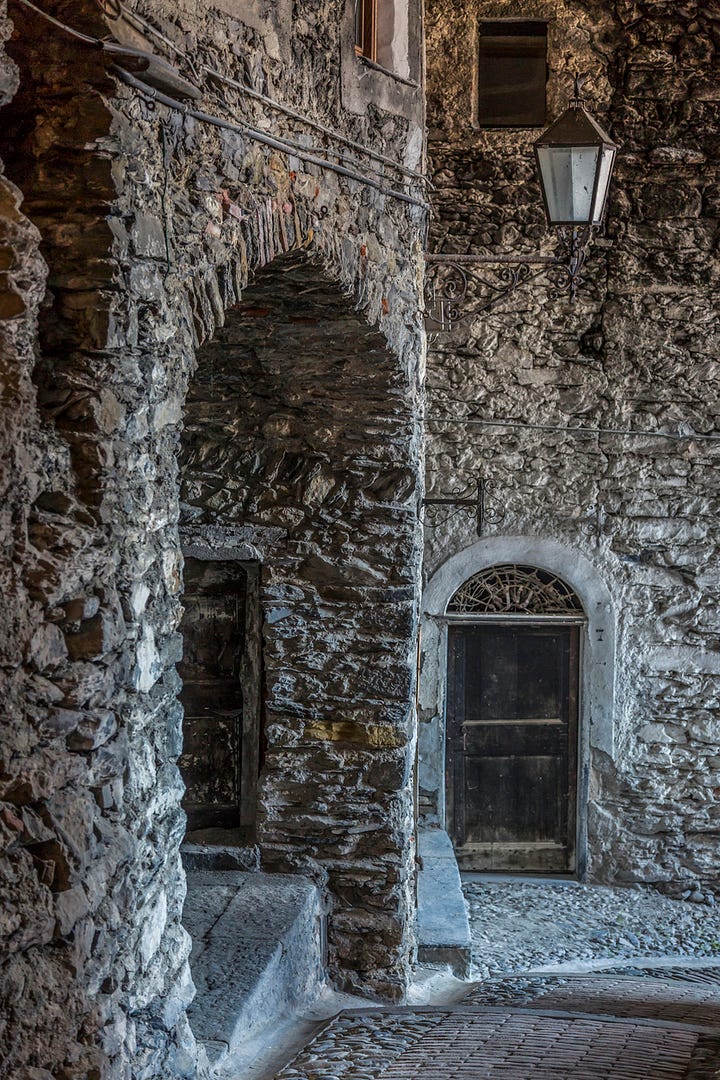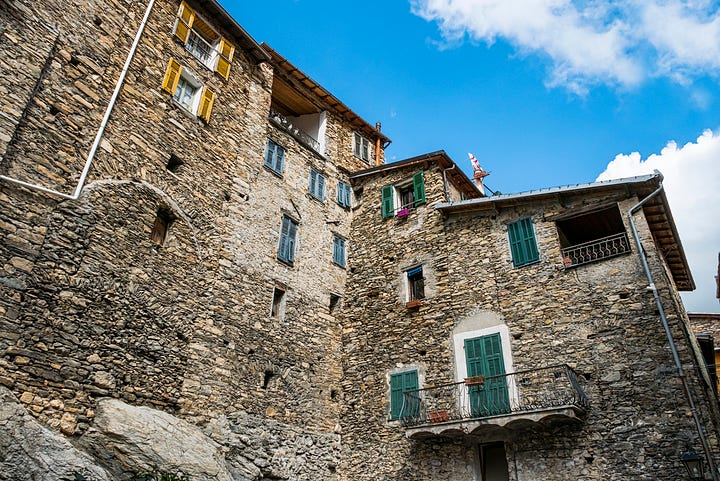💚🤍❤️ Triora Village of Wonder and Witches
A Ligurian adventure in the mystical land of the Valle Argentina!
Nestled in the stunning Valle d'Argentina, near the impressive Monte Saccarello, lies the charming mediaeval Triora. It's only an hour's drive from the Ligurian Riviera dei Fiori coast. The village is surrounded by the breathtaking beauty of the Parco Naturale Regionale delle Alpi Liguri, a protected area home to mesmerizing flora and fauna, where nature flourishes with Lavender, Elderberry, Thyme, Rosemary, and Mountain Maple among the plant species that thrive in this sanctuary.
Mountain Maple is known here as Stregonella or Erba della Madonna, and it is believed to bring peace and calmness when placed under one's pillow. The wildlife is just as diverse, with golden eagles, fallow deer, chamois, and roebucks making their home in the reserve. With designated paths for hiking, cycling, and horse riding, you can fully immerse yourself in the bounty of nature.
Triora is included in I Borghi piu belli d’Italia, for those who don’t know: an association that aims to conserve and advertise historic villages in Italy. Additionally, it has been awarded La bandiera arancione, a premium bestowed by the TCI, the Touring Club Italiano, for its exceptional elegance and high-quality hospitality. Triora has also developed an App and a website called Triora da scoprire for you to discover all the village's attractions. To access, click the link provided at the end of this newsletter.
What’s in a name?
We found several explanations for the name Triora; according to its official website, it derives from the Latin word tres or tria for three and ora for mouths, indicating the area’s three primary nutrients: grain, vines, and chestnuts. Others believe that there is a link with the illustration of Cerbero, the three-headed dog from Dante's Inferno depicted on the coat of arms of Triora, or with the three torrents that run through the valley here: the Corte, the Argentina, and the Capriolo.
Food and more!
Do you have a love for good food?
The gastronomy of Triora boasts its tradizione della cucina povera, a culinary tradition originally used by those experiencing poverty and cooked with natural products available to them. Today it is greatly appreciated and offers a variety of delicious dishes. For example, a basic pasta, different from the usual gnocchi and orecchiette due to its shape, and pizza, called Torta Pasta here, with herbs, potato or zucchini depending on the season. The village is also known for its traditional round shaped loaves of bread, to combine with a tasty ricotta-like Alpine cheese, called Bruzzo, or Toma di pecora brigasca, a goat cheese. Grano pestato is a hand-ground grain, cooked and combined with onion, leek and bacon, or dishes with mushrooms from the forest, beans, saffron, or chestnuts. Another local delicacy are the snails. On top of all these goodies, Triora is known for its dolce, a dessert called Cubaita, a dough pastry filled with hazelnut, almond and walnut in local honey. To complement your meal, try some local wines, the red Ormeasco or the white Bunde.
Exploring the rich historical heritage of Triora
In addition to a culinary tradition, Triora offers a rich historical heritage with captivating sites, such as a labyrinthine Centro storico, its old town, with caruggi, narrow alleys, with round-arched gates leading to sunny squares.
There are towering houses with striking black slate doors; some even feature illustrations of coats of arms. You can also visit historic public ovens like the Carriera and Rocca ovens, which bakers once used to bake their traditional bread. Additionally, you can visit the oldest antique fountain in the region, known as La Fontana Soprana.
The ruins of Il Castello provide an impression of the former rock fortress built by the Genovese to defend their territory from the time that Triora fell under the jurisdiction of the Repubblica di Genova.
Art and devotion
The Collegiata di nostra Signora Assunta is an impressive church built upon the remnants of a pre-Christian cult. The late Gothic-style bell tower and neoclassical façade magnify its grandeur. Inside, visitors can discover numerous works of art, such as Il Battesimo di Cristo (1397), The Baptism of Christ, painted by Taddeo di Bartolo (1363-1422), an artist from Siena. Additionally, there is a crucifix created by sculptor Anton Maria Maragliano (1664-1739) and relics are preserved of the Saints San Giovanni da Triora (1760-1816), a Franciscan monk and martyr, and San Tusco, a vital saint for the Trioresi, despite little being known about his life.
The Oratorio di San Giovanni Battista houses an art collection from the fifteenth, sixteenth, and seventeenth centuries created by Italian artists such as Luca Cambiaso (1527-1585) and Lorenzo Gastaldi (1625-1690). Additionally, a sculpture in wood created by Anton Maria Maragliano portraying San Giovanni Battista, Saint John the Baptist, can be seen here and one depicting the same saint by local artist Giovanni Battista Borgogno, whose dates are unknown. In addition, works of art from the Chiesa di San Dalmazzo, dedicated to Saint Dalmatius, have been transferred here due to restoration work.
The Palazzo Stella, dating back to the fourteenth century, was once the home of the prestigious Stella family from Genova. The building has a dark history intertwined with a tragic past that shook the community of Triora, resulting in the mountain village being referred to as Il paese delle streghe, the village of the witches.


Here’s the story:
The witches of Triora.
In 1588, some women of Triora were accused of practising witchcraft. Try to imagine how it must have been for them in a village gripped by fear and superstition, where having a deviant lifestyle, or being seen dancing in the woods, was enough to be identified as a witch.
The podestà of the village, a prominent magistrate, sought advice from authorities in Albenga and Genova, and inquisitors were dispatched to investigate. In the ensuing chaos, the group of women was arrested and imprisoned.
Giulio Scribani, the Special Commissioner of the Inquisition, arrived in Triora's Palazzo Stella from Genova. He was there to replace the previous investigators and was convinced that the women involved had made a deal with the devil. As a result, he arrested even more of them, leading to a series of tragic witch trials.
In 1618, the witch trials were concluded, and the last surviving women were released after years of imprisonment.
What do we know about these persecuted women in Triora?
Some of the women, we know by name from the authentic reports of the witch trials; Franchetta Borelli for example, or Isotta Stella, a noblewoman who died in the Palazzo Stella due to the torture she was subdued to, to force her to confess.
We also know that they had an extensive knowledge of the beneficial herbs that grow in the hills. This enabled them to offer advice and remedies for the health and well-being of the villagers. Additionally, they were skilled in assisting women during childbirth. As healers and midwives, they had a significant and positive impact on Triora and the neighboring areas.
In addition it is known that none of the women accused in Triora were burned at the stake.
For further reading, I refer to the article Dramatically True, The Legacy of Franchetta Borelli, by historian Paulo Portone (link at the end of this newsletter).
At the Museo etnografico e della Stregoneria, the Museum of Ethnology and Witchcraft, a permanent exhibition, highlights the positive impact the wrongly accused women have had on their community, giving them a platform to share their stories.
Visitors of Triora can also explore the Cabotina, a cavern once believed to be the ‘witches’ dwelling and gathering place.
Important too, in this context, is the Chiesa di San Bernardino, dedicated to Saint Bernard of Siena (1380-1444), who travelled to the Valle d’Argentina to preach and came to Triora around 1418.
The walls of this chapel are adorned with fifteenth century pastel-coloured frescoes, attributed to different artists. Among them is Il Giudizio Universale, The Last Judgement, which portrays the idea of good and evil, heaven and hell in a powerful manner. The artwork includes images of demonic creatures, women wearing mitres and heretics being burned.
For more information, see the article We Pray, Christianity in Triora, by local historian Sandro Oddo (link at the end of this newsletter).
The Triora Cat monument
A few weeks ago, I came across an intriguing, recent testimony, that piqued my interest in the form of a press release. It was about a project called Il Gatto di Triora, The Triora Cat Project, initiated by author-philosopher Svetlana Lin. It involved the creation of a massive sculpture of a cat that could be seen from all around the hills.
Why a cat?
Ancient Egyptian culture revered and even worshipped cats. Upon their introduction to Europe, cats were considered a portafortuna, as they were believed to bring good luck and protect households. However, in the Middle Ages, the Catholic Church associated cats with the devil and witchcraft, leading to mistreatment during the witch hunts. Sadly, many cats perished alongside their owners.
In June 2023, a nine-foot-tall bronze sculpture of a cat created by artist Elena Rede was inaugurated in Piazza Castello in Triora to recognise this wrong. It serves as a symbolic gesture of pardon we as humans can express towards all the animals that suffered, a Grand Pardon, as the project's initiators say, and a call to end ignorance and abuse towards them.
The witchcraft theme today is creatively incorporated by several B&Bs, restaurants, and shops that offer local products. For fun, front doors are adorned with witch dolls or brooms for visitors to appreciate. Every year on the Sunday after Ferragosto, Assumption Day (August 15th), Strigora is celebrated, a theatrical folk witch festival with pointed hats, magical secret recipes, and dance.
Conclusion
In Triora history, nature, and mysticism intertwine to create a unique and captivating experience, come and enjoy la magia di Triora, the magic of Triora!
Sources:
Ufficio Informazioni e di Accoglienza Turistica (I.A.T.), 7. Corso Italia - Triora
Paolo Portone, Dramatically True, The legacy of Franchetta Borelli.
Sandro Oddo, We pray, Christianity in Triora.
Photos:
Photo 1 Gablitz, 2 and 6 Michele Vacchiano, 3 Peste65, 4 Tinieder, 5 Nicola Colombo, I Stock.
Photo Chiesa di San Bernardino, Jk4u59, Wikimedia Commons
Photo Cat figure in bronze by Elena Rede, Facebook Il gatto di Triora









